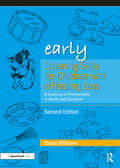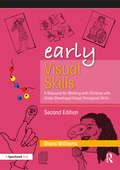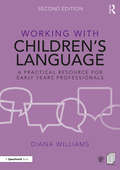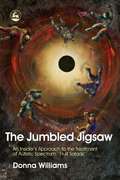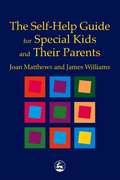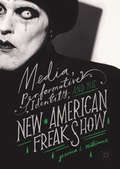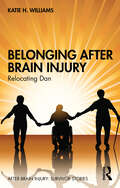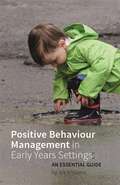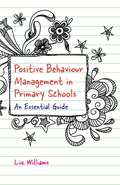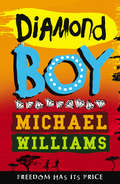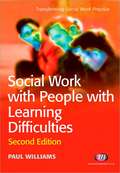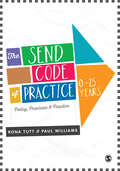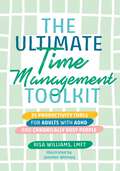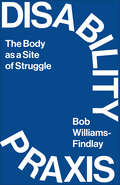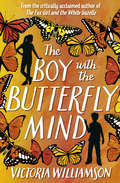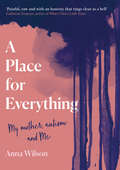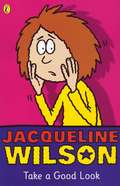- Table View
- List View
Early Listening Skills for Children with a Hearing Loss: A Resource for Professionals in Health and Education (Early Skills)
by Diana WilliamsNow in a revised and updated second edition, Early Listening Skills is a practical manual for use with children and young people with underdeveloped listening skills related to hearing loss. Thirteen clear and easy to follow sections focus on skills such as auditory detection, discrimination, recognition, sequencing and memory. Each one is filled with a series of carefully designed activities to stimulate and develop auditory awareness and discrimination skills in children with a range of developmental levels and abilities. Features include: A wide range of activities suited to both the early years and home settings Links to the Early Years Foundation Stage (EYFS) framework and topics reflecting the EYFS and Key Stage 1 curriculum Photocopiable material designed to document the child’s development over time As most of the activities are non-verbal, they are well suited for children with limited spoken language as well as children with special educational needs and disability and English as an additional language (EAL) learners. Whilst primarily designed for early years practitioners, special educational needs co-ordinators (SENCOs), specialist teachers, therapists and other professionals, the activity sheets and guidance also make it an invaluable tool for parents and caregivers looking to stimulate listening skills at home.
Early Visual Skills: A Resource for Working with Children with Under-Developed Visual Perceptual Skills (Early Skills)
by Diana WilliamsNow in a revised and updated second edition, Early Visual Skills is a practical manual for use with children and young people who have underdeveloped visual perceptual skills. Twelve clear and easy-to-follow sections, focusing on skills such as attention, discrimination, sequencing, concentration and memory, are filled with carefully designed activities to stimulate visual attention and discrimination skills in children with a range of developmental levels and abilities. Features include: A wide range of activities suited to both the early years and home settings Links to the Early Years Foundation Stage (EYFS) framework and topics reflecting the EYFS and the Key Stage 1 curriculum Photocopiable materials designed to document the child’s development over time As most of the activities are non-verbal, they are well suited for children with limited spoken language, including EAL (English as an Additional Language) learners, the deaf, sensory impaired, or those with autism or learning difficulties. Whilst primarily designed for early years practitioners, SENCOs (Special Educational Needs Coordinator), specialist teachers, therapists and other professionals, there are activity sheets and guidance for parents to provide them practical advice on how to stimulate visual perceptual skills at home, turning their child’s everyday routines into opportunities to stimulate visual awareness.
Working with Children’s Language: A Practical Resource for Early Years Professionals (Working With)
by Diana WilliamsThis revised and updated second edition of Working with Children’s Language has been created to support practitioners who work with young children with delayed language acquisition. Rooted in a developmental theory of language learning, it covers topics such as attention control and listening, the role of play, verbal comprehension and the acquisition of spoken expressive language. Each chapter offers a straightforward overview of current research relating to the specific language skill before introducing a wealth of targeted games and activities that can help support the development of those skills. Key features include: • A structured approach to language learning that can be followed as a programme or adapted for informal use by individual practitioners. • Accessible activities, games and ideas suitable for small group or individual intervention, linked to specific aims based on developmental norms. • Photocopiable and downloadable resources, including a record sheet to track progress in each skill against aims and outcomes for individual children. Clearly linking theory and practice in an engaging and easy-to-follow format, this is an invaluable resource to support children in early years settings and Key Stage 1 whose language is delayed, but who are otherwise developing normally. It is a must-have book for early years practitioners, teachers, SEND professionals and speech and language therapists with varying levels of experience.
Working with Children’s Language: A Practical Resource for Early Years Professionals (Working With)
by Diana WilliamsThis revised and updated second edition of Working with Children’s Language has been created to support practitioners who work with young children with delayed language acquisition. Rooted in a developmental theory of language learning, it covers topics such as attention control and listening, the role of play, verbal comprehension and the acquisition of spoken expressive language. Each chapter offers a straightforward overview of current research relating to the specific language skill before introducing a wealth of targeted games and activities that can help support the development of those skills. Key features include: • A structured approach to language learning that can be followed as a programme or adapted for informal use by individual practitioners. • Accessible activities, games and ideas suitable for small group or individual intervention, linked to specific aims based on developmental norms. • Photocopiable and downloadable resources, including a record sheet to track progress in each skill against aims and outcomes for individual children. Clearly linking theory and practice in an engaging and easy-to-follow format, this is an invaluable resource to support children in early years settings and Key Stage 1 whose language is delayed, but who are otherwise developing normally. It is a must-have book for early years practitioners, teachers, SEND professionals and speech and language therapists with varying levels of experience.
The Jumbled Jigsaw: An Insider's Approach to the Treatment of Autistic Spectrum `Fruit Salads'
by Donna WilliamsThe Jumbled Jigsaw exposes autism spectrum disorders (ASDs) not as single entities but as a combination of a whole range of often untreated, sometimes easily treatable, underlying conditions. Exploring everything from mood, anxiety, obsessive-compulsive and tic disorders to information processing and sensory perceptual difficulties, including dependency issues, identity problems and much more, Donna demonstrates how a number of such conditions can combine to form a 'cluster condition' and underpin the label 'autism spectrum disorder'. Donna Williams encourages and empowers families to look at what they can do to change their child's environment to address anxiety, overload and other issues. She also gives carers the necessary information to navigate the booming autism marketplace and demand the right tools for the job. The author also challenges professionals to adopt a multi-disciplinary approach to identifying and treating the cluster conditions that make up an autism spectrum diagnosis, and to improve service delivery to those in need. The Jumbled Jigsaw is a call to modern society to take responsibility and accept diversity. It is written in a very human and user-friendly way for parents and for Auties and Aspies themselves, but it is also aimed at carers, professionals, policy-makers and service providers.
The Jumbled Jigsaw: An Insider's Approach to the Treatment of Autistic Spectrum `Fruit Salads' (PDF)
by Donna WilliamsThe Jumbled Jigsaw exposes autism spectrum disorders (ASDs) not as single entities but as a combination of a whole range of often untreated, sometimes easily treatable, underlying conditions. Exploring everything from mood, anxiety, obsessive-compulsive and tic disorders to information processing and sensory perceptual difficulties, including dependency issues, identity problems and much more, Donna demonstrates how a number of such conditions can combine to form a 'cluster condition' and underpin the label 'autism spectrum disorder'. Donna Williams encourages and empowers families to look at what they can do to change their child's environment to address anxiety, overload and other issues. She also gives carers the necessary information to navigate the booming autism marketplace and demand the right tools for the job. The author also challenges professionals to adopt a multi-disciplinary approach to identifying and treating the cluster conditions that make up an autism spectrum diagnosis, and to improve service delivery to those in need. The Jumbled Jigsaw is a call to modern society to take responsibility and accept diversity. It is written in a very human and user-friendly way for parents and for Auties and Aspies themselves, but it is also aimed at carers, professionals, policy-makers and service providers.
The Self-Help Guide for Special Kids and their Parents
by James Matthew Williams Joan MatthewsJames Williams is an SP or special person - he was diagnosed with autism during early childhood. His mother, Joan Matthews, is an NP or normal person. As James grew up, his different perception of the world and the lack of understanding from NPs created problems. Together, he and his mother met the challenges with ingenuity and humour. One day, while taking a walk, James and Joan decided to write a book of their practical solutions. The Self-Help Guide for Special Kids is that book. Covering everything from eye sensitivity, to knowing how far away to stand from other people, to being polite when someone is crying, James and Joan's book describes the problems that an SP may face, and the solutions which they have found to work successfully. Pervaded by their caustic humour and common sense, The Self-Help Guide for Special Kids will be invaluable to other SPs and their families both as a source of advice and a fresh and witty account of how it feels to be an SP.
Media, Performative Identity, and the New American Freak Show
by Jessica L. WilliamsThis book traces how the American freak show has re-emerged in new visual forms in the 21st century. It explores the ways in which moving image media transmits and contextualizes, reinterprets and appropriates, the freak show model into a “new American freak show.” It investigates how new freak representations introduce narratives about sex, gender, and cultural perceptions of people with disabilities. The chapters examine such representations found in horror films, including a prolonged look at Freaks (1932) and The Texas Chainsaw Massacre (1974), documentaries such as Murderball (2005) and TLC’s Push Girls (2012-present), disability pornography including the pornographic documentary Sick: The Life and Death of Bob Flanagan Supermasochist (1997), and the music icons Marilyn Manson and Lady Gaga in their portrayals of disability and freakishness. Through this book we learn that the visual culture that has emerged takes the place of the traditional freak show but opens new channels of interpretation and identification through its use of mediated images as well as the altered freak-norm relationship that it has fostered. In its illumination of the relationship between normal and freakish bodies through different media, this book will appeal to students and academics interested in disability studies, gender studies, film theory, critical race theory, and cultural studies.
Media, Performative Identity, and the New American Freak Show
by Jessica L. WilliamsThis book traces how the American freak show has re-emerged in new visual forms in the 21st century. It explores the ways in which moving image media transmits and contextualizes, reinterprets and appropriates, the freak show model into a “new American freak show.” It investigates how new freak representations introduce narratives about sex, gender, and cultural perceptions of people with disabilities. The chapters examine such representations found in horror films, including a prolonged look at Freaks (1932) and The Texas Chainsaw Massacre (1974), documentaries such as Murderball (2005) and TLC’s Push Girls (2012-present), disability pornography including the pornographic documentary Sick: The Life and Death of Bob Flanagan Supermasochist (1997), and the music icons Marilyn Manson and Lady Gaga in their portrayals of disability and freakishness. Through this book we learn that the visual culture that has emerged takes the place of the traditional freak show but opens new channels of interpretation and identification through its use of mediated images as well as the altered freak-norm relationship that it has fostered. In its illumination of the relationship between normal and freakish bodies through different media, this book will appeal to students and academics interested in disability studies, gender studies, film theory, critical race theory, and cultural studies.
My Son's Not Rainman: One Man, One Autistic Boy, A Million Adventures
by John WilliamsThis isn’t a story about autism. It’s a story about a young boy who happens to have autism, and there is a difference.John Williams is a stand-up comedian. He is also a single father and full-time carer for his son, who has autism and cerebral palsy. This is their incredible story.In 2012, John started a blog called My Son’s Not Rainman, a heartfelt and uplifting account of everyday life for him and ‘The Boy’. Following on from the blog’s amazing success, John felt there was still much more of their life, past and present, that he wanted to share. And not only of the challenges of bringing up a child who for too long was just dismissed as ‘difficult’, but also of the joy of living with someone who looks at the world in a unique way.My Son’s Not Rainman radiates warmth, care and passion, not to mention laugh-out-loud humour, on every page. It is a brilliantly different story about a brilliantly different boy.
Belonging After Brain Injury: Relocating Dan (After Brain Injury: Survivor Stories)
by Katie H. WilliamsBelonging After Brain Injury: Relocating Dan explores the life of the author’s brother who has dealt with the effects of a severe traumatic brain injury (TBI) for over four decades. It recounts the institutional, psychological, and social labyrinths he and his family have navigated following the TBI he sustained at the age of eighteen. This insightful volume offers a holistic account of the impact of TBI on the survivor and his family. It reveals the difficulties a TBI survivor has had to endure and provides practical information about physical, psychological, and psychosocial symptoms and their consequences. Dan’s story offers new perspectives and strategies that will help alleviate seemingly intractable problems and highlights the central importance of forming connections with others in order to lead a fuller life. The author’s account of her own journey, learning to help care for and advocate for Dan, offers an invaluable guide for TBI survivors and those who care for and support them. Belonging After Brain Injury: Relocating Dan will be of interest to TBI survivors and their families. Its rich insights will be essential reading for medical and mental health professionals, as well those involved in the care and rehabilitation of TBI survivors and families.
Belonging After Brain Injury: Relocating Dan (After Brain Injury: Survivor Stories)
by Katie H. WilliamsBelonging After Brain Injury: Relocating Dan explores the life of the author’s brother who has dealt with the effects of a severe traumatic brain injury (TBI) for over four decades. It recounts the institutional, psychological, and social labyrinths he and his family have navigated following the TBI he sustained at the age of eighteen. This insightful volume offers a holistic account of the impact of TBI on the survivor and his family. It reveals the difficulties a TBI survivor has had to endure and provides practical information about physical, psychological, and psychosocial symptoms and their consequences. Dan’s story offers new perspectives and strategies that will help alleviate seemingly intractable problems and highlights the central importance of forming connections with others in order to lead a fuller life. The author’s account of her own journey, learning to help care for and advocate for Dan, offers an invaluable guide for TBI survivors and those who care for and support them. Belonging After Brain Injury: Relocating Dan will be of interest to TBI survivors and their families. Its rich insights will be essential reading for medical and mental health professionals, as well those involved in the care and rehabilitation of TBI survivors and families.
Positive Behaviour Management in Early Years Settings: An Essential Guide
by Liz WilliamsDrawing on her extensive practical experience, Liz Williams provides a highly accessible and much-needed guide to promoting positive behaviour in early years settings. In this book, she explains why children may act in the way that they do and how behaviour should be understood differently in children of different ages. She demonstrates that social and emotional capacities differ greatly in these crucial development years and how this impacts on the support needed at each stage. The book considers a host of factors influencing positive behaviour, such as environments and the importance of planning, and looks beyond the child to show the vital role that staff and parents have in promoting appropriate behaviour. Written in clear and understandable language, this book is full of ideas that early years workers can easily implement in their day-to-day work.
Positive Behaviour Management in Early Years Settings: An Essential Guide (PDF)
by Liz WilliamsDrawing on her extensive practical experience, Liz Williams provides a highly accessible and much-needed guide to promoting positive behaviour in early years settings. In this book, she explains why children may act in the way that they do and how behaviour should be understood differently in children of different ages. She demonstrates that social and emotional capacities differ greatly in these crucial development years and how this impacts on the support needed at each stage. The book considers a host of factors influencing positive behaviour, such as environments and the importance of planning, and looks beyond the child to show the vital role that staff and parents have in promoting appropriate behaviour. Written in clear and understandable language, this book is full of ideas that early years workers can easily implement in their day-to-day work.
Positive Behaviour Management in Primary Schools: An Essential Guide
by Liz WilliamsThis highly accessible and much-needed resource sets out practical advice on positive behaviour management in primary schools, exploring how to support children effectively with their personal, social and emotional development. With an emphasis on implementable strategies, this book will give primary school teachers and staff an understanding as to why children may behave as they do, and what steps can be taken by the school to support a child's development. Considering a variety of factors that influence positive behaviour, such as environment, mental health, parents, and the importance of planning, this book is full of ideas that can be dipped in and out of for support in the classroom. Bite-sized and practical, this is a perfect book for busy teachers.
Diamond Boy
by Michael Williams'Diamonds for everyone.' That's what fifteen-year-old Patson Moyo hears when his family arrives in the Marange diamond fields, leaving his previous life, school and friends behind with hopes for a better life. Soon Patson is working in the mines along with four friends in the Gwejana Syndicate – teen diamond miners, secretly pooling their profits and hoping to find the priceless stone that will change everything. But when the government's soldiers come to Marange, Patson's world is shattered. Set against the backdrop of President Mugabe's brutal regime in Zimbabwe, this is the story of a young man who succumbs to greed, but finds his way out through a transformative journey to South Africa in search of his missing sister, in search of freedom, and in search of himself.
Social Work with People with Learning Difficulties
by Paul WilliamsCurrent practice in the field is driven by the government White Paper 'Valuing People' (2001), which declared radical aims for services for people with learning difficulties. This fully revised second edition includes key updates on this White Paper and provides an up-to-date evaluation of the progress made towards those aims. Using case studies, activities and further reading to reinforce learning, this book explores an important area of social work practice and examines the varied roles social workers might undertake - including the achievements and satisfaction of working with service users with learning difficulties and challenges.
The SEND Code of Practice 0-25 Years: Policy, Provision and Practice
by Paul Williams Rona TuttConsidering it for your course reading list? Lecturers can order their e-inspection copy here today! How have you found the changes brought about by the new SEND Code of Practice: 0-25 years (2014)? This book is the ultimate guide to making sure that you are not only meeting the requirements, but are improving outcomes for children and young people as well. Written for all professionals working in the field, it covers: · The broader Children and Families Act (2014) · The role of the local authority · Guidance on all the key changes that school leaders, SENCO's, and staff are concerned about · Case studies of settings across the 0-25 age range, including maintained schools, academies, free schools, and specialist and alternative provision. Whether you work in education, health, or social care, or are training to do so, this book will genuinely improve your provision and practice for children and young people with SEND.
Learning Disabilities and e-Information: Navigating the Electronic Hypermaze
by Peter WilliamsDigital Technology is becoming ever more used by people with learning disabilities for information, entertainment and to enjoy self-expression. Despite this, there is a paucity of research into how this cohort negotiate electronic interfaces, interpret images, navigate pages and read online; what barriers there might be, and how these could be obviated. This book explores these issues, establishing how these and other factors facilitate or inhibit information access and behaviour more generally. There are plenty of guidelines and accessibility standards regarding electronic information presentation, but most are outdated or have been formulated without empirical evidence. Unlike prior literature this book is the result of many years's research in the field, considers specific information contexts, and develops new concepts in information behaviour. It is written in non-technical, jargon-free language, relevant for academics, students and professionals; from human-computer interaction researchers, learning disability specialists and information scientists to formal and informal carers and supporters, college tutors, family members and others.
Learning Disabilities and e-Information: Navigating the Electronic Hypermaze
by Peter WilliamsDigital Technology is becoming ever more used by people with learning disabilities for information, entertainment and to enjoy self-expression. Despite this, there is a paucity of research into how this cohort negotiate electronic interfaces, interpret images, navigate pages and read online; what barriers there might be, and how these could be obviated. This book explores these issues, establishing how these and other factors facilitate or inhibit information access and behaviour more generally. There are plenty of guidelines and accessibility standards regarding electronic information presentation, but most are outdated or have been formulated without empirical evidence. Unlike prior literature this book is the result of many years's research in the field, considers specific information contexts, and develops new concepts in information behaviour. It is written in non-technical, jargon-free language, relevant for academics, students and professionals; from human-computer interaction researchers, learning disability specialists and information scientists to formal and informal carers and supporters, college tutors, family members and others.
The Ultimate Time Management Toolkit: 25 Productivity Tools for Adults with ADHD and Chronically Busy People (Ultimate Toolkits for Psychological Wellbeing)
by Risa WilliamsDo you find time constantly slipping away from you? Or does completing a to-do list feel totally unachievable? We all have 24 hours in a day, but sometimes putting them to good use can feel like an impossible task. The Ultimate Time Management Toolkit is here to change that!Written by a clinical therapist and author of The Ultimate Anxiety Toolkit, this book focuses on practical methods and strategies, including creative worksheets and easy to use techniques, to help you find your motivation, achieve your goals and feel less stressed about organizing your time.With 25 different techniques based on CBT, mindfulness and narrative therapy, you can find out which strategies work best for you to help transform how you use your time and learn how to feel empowered to make positive changes to habits in your daily life.
Disability Praxis: The Body as a Site of Struggle
by Bob Williams-Findlay‘A masterful intervention that is particularly pertinent for an age of austerity, pandemic, and rising living costs’ Robert Chapman, author of Empire of Normality‘A brilliant and much-needed contribution to current debates’ Ioana Cerasella Chis, University of Birmingham‘A comprehensive analysis which also intelligently looks at how disability can fit into the modern world’ Joshua Hepple, activist, writer and disability equality trainerThe rise of the extreme right globally, the crisis of capitalism and the withdrawal of all but the most punitive arms of the state are having a disastrous impact on disabled people’s lives. Bob Williams-Findlay offers an account of the transformative potential of disability praxis and how it relates to disabled politics and activism. He addresses different sites of struggle, showing how disabled people have advanced radical theory into the implementation of policies.Examining the growth of the global Disabled People’s Movement during the 1960s, Williams-Findlay shows how a new social discourse emerged that shifted the focus away from seeing disability as restrictions on an individual’s body, towards understanding the impact of restrictions created by capitalist relations. He shines light on the contested definitions of disability, asking us to reconsider how different socio-political contexts produce varied understandings of social oppression and how we can play a role in transforming definitions and societies.Bob Williams-Findlay is the founder of Birmingham Disability Rights Group and the former Chair of the national organisation BCODP. He has written in various publications on the topic of disability politics.
The Boy with the Butterfly Mind (Kelpies Ser.)
by Victoria WilliamsonJamie Lee just wants to be normal but his ADHD isn't making it easy. If only he could control his butterfly mind then he'd have friends, be able to keep out of trouble, live with his mum and not be sent to stay with his dad.Elin Watts just wants to be perfect. If she could be the best student and daughter possible, then maybe her dad would leave his new family and come back to Glasgow to live with Elin and her mum, happily ever after.When Jamie and Elin's families blend, the polar opposites of chaotic Jamie and ordered Elin collide. As their lives spiral out of control, Jamie and Elin discover that they're actually more alike than they'd admit. Maybe there's no such thing as normal, or perfect. And perhaps, just like families, happy-ever-afters come in all shapes and sizes.Uplifting and moving, The Boy with the Butterfly Mind is an inspiring story of acceptance, blended families, and discovering that in the end, being yourself is more than enough.
A Place for Everything
by Anna Wilson‘Painful, raw and with an honesty that rings clear as a bell’ Catherine Simpson, author of When I Had a Little Sister A searing account of a mother’s late-diagnosis of autism – and its reaching effects on a whole family.
Take a Good Look
by Jacqueline WilsonMary is fed up of being wrapped in cotton wool by her gran. Being blind doesn't mean that she can't look after herself. So Mary decides to go down to the sweetshop by herself for the first time but the trip is more eventful than she could ever have imagined and the shop is burgled whilst Mary is in there! How will she escape and get home safely?
